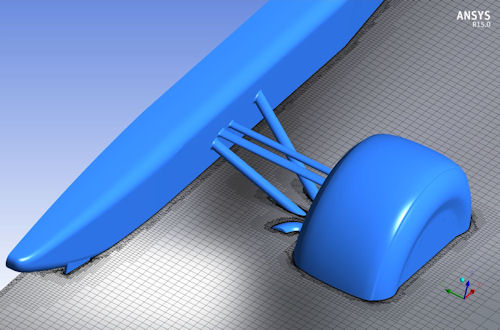February 14, 2014
By Anthony J. Lockwood
Dear Desktop Engineering Reader:Since this is Valentine’s Day, I’ll admit that my heart goes out to all of you analysts who mesh around fixing dirty geometry. Your job is Exhibit A that some things are never easy. But some things do not have to be as arduous as you’ve come to expect either. And an easier way to do a gnarly, exacting and tedious job is the theme of today’s Check it Out submission.
 |
“Meshing Large and Complex Geometries with ANSYS Fluent Meshing” is a brand new presentation in the ongoing “Fluid Dynamics Technology Tips” web resource series from ANSYS Corp. It went live yesterday, and it’s quite well executed.
The focus of this Technology Tip is on how you go about pre-processing complex and dirty CAD geometry for CFD (computational fluid dynamics) analysis with the ANSYS Fluent pre-processing tool. And if you are not an ANSYS Fluent user, then an added focus, albeit unstated, is comparing how you’re handling CFD pre-processing now versus how you could be handling the job.
For our purposes here, we define complex geometry as ranging from 100 parts or bodies to 1,000 or more parts or bodies. Dirty means geometry that came with the usual suspects such as gaps, holes, intersecting faces, surface meshes badly needing improvement, and so on.
I heard some of you groaning about various 1000-part nightmares you wrestled with for days on end. After all, great swaths of an engineer’s progression on the actuarial tables of time can be spent manually cleaning up large, complex CAD files and surface mesh files. Putting aside the joys of manually fixing geometry, your assignment may demand high resolution. And that means a huge number of computationally intensive mesh elements. So what this all boils down to is that long before you get down to running a simulation, your productivity and efficiency can be severely challenged by what is considered a normal CFD pre-processing cycle.
OK, so, that’s your table setting for this web-based resource’s menu of data. What you’ll first find on the landing page are some quick details on what differentiates ANSYS Fluent meshing as well as some of its benefits. These are things like the ability to import CAD or surface meshes, diagnostic tools to find and fix problems, speed and scalability.
Scroll down a bit and you’ll see some screen captures of a meshed Formula 1 racecar and, below that, a video link. Hit the link. It takes you to the first video in a 5-part demonstration of different ANSYS Fluent meshing strategies. That Formula One racecar geometry serves as the string tying together the videos.
None of the videos are long; they range from about 8 minutes to nearly 13 minutes. The narration is engineer-to-engineer straightforward technical. It assumes you have a working knowledge of CFD pre-processing and that you want to learn something without being subject to marketing hoo-hah. Balloon popups pinpoint and re-iterate key concepts or commands.
The first video covers quick CAD import and how to create a high-quality surface mesh for volume meshing. From there, it’s a progression of topics: remeshing surfaces directly at CAD import using a pre-specified size field file; creating a tet-prism volume mesh from a conformal surface mesh; remeshing a tet-prism volume mesh with a hexcore mesh; and improving surface meshes locally. (Hint: When a video ends, you see one of those YouTube multi-panel displays of mostly similar video offerings. The next video in the series is the top left one.)
The scope of this new ANSYS Technology Tip is tight, and therein lays its strength. See, if you are using the ANSYS Fluent meshing pre-processing tool, you are bound to pick up a tip or two to make your work more efficient. If you are not an ANSYS Fluent user, you get an excellent presentation to measure and compare what you’re doing to prepare geometry with your tool versus Fluent. Wherever you fall, someone at ANSYS put their heart into creating this Technology Tip, and they did a good job. Interesting stuff. Hit the link and check it out.
Thanks, Pal. – Lockwood
Anthony J. Lockwood
Editor at Large, Desktop Engineering
Meshing Large and Complex Geometries with ANSYS Fluent Meshing
Subscribe to our FREE magazine, FREE email newsletters or both!
About the Author
Anthony J. Lockwood is Digital Engineering’s founding editor. He is now retired. Contact him via [email protected].
Follow DE





